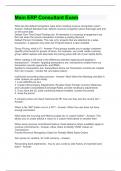Exam (elaborations)
Main ERP Consultant Exam Questions and Answers
- Module
- Main ERP Consultant Exam
- Institution
- Main ERP Consultant Exam
Main ERP Consultant Exam What are the default recognition rules when creating revenue recognition rules? - Answer- Default Standard rule: defines revenue recognition plans that begin and end on the same date Default One-Time Direct Posting rule: All elements in a revenue arrangement use this ru...
[Show more]



